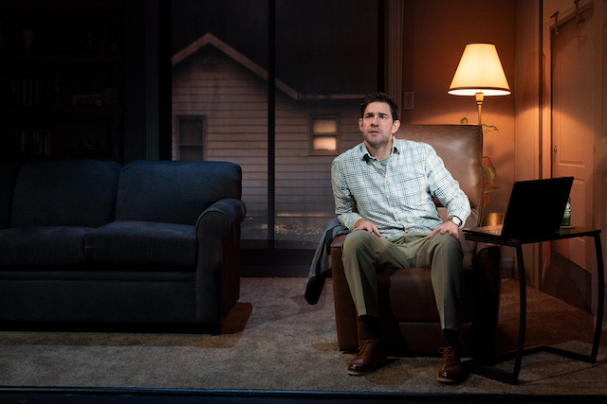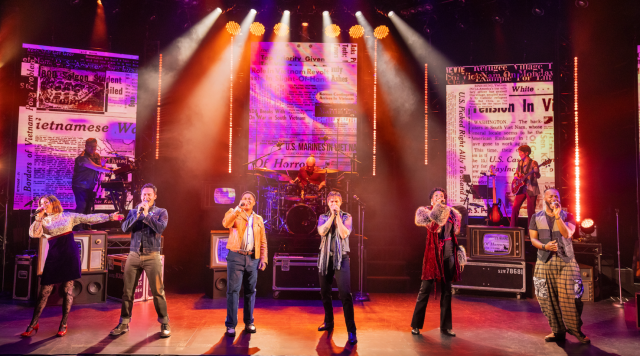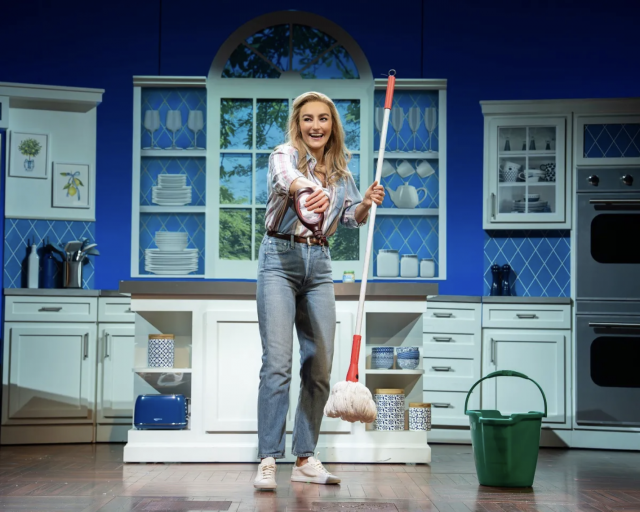
Rory Nolan (Photo: HanJie Chow)
Endgame
By David Schultz
The highly regarded Irish theatre company, Druid, has returned to New York City with a limited run of Samuel Beckett’s Theatre of the Absurd classic, Endgame. In a rare coincidence, Beckett’s more famous Waiting for Godot is currently running on Broadway with a starry cast, drawing in huge crowds. This Off-Broadway play at the Irish Arts Center is the real thing, performed with impeccable craft, a macabre nightmare of a masterpiece.
In a tightly wound ninety minutes, this dark post-apocalyptic tale is bleak and yet oddly moving. The four characters trapped in never-ending inter-dependent yet antagonistic relationships are: Hamm (Rory Nolan), a bitter, blind man in a wheelchair; Clov (Aaron Monaghan) an emotionally abused servant that caters to Hamm’s every whim and fancy; Two large trash cans displayed upstage contain Hamm’s parents, Nell (Marie Mullen) and his father Nagg (Bosco Hogan). These elders occasionally are shown, trapped in their claustrophobic bins, as they converse with the same well–worn tales that they tell each other in never-ending circuitous banter. They all, as is typical of Beckett, use words and repetitive verbal arias to stave off the post-apocalyptic world outside. Something menacing and unspoken has happened outside. These people might well be the very last vestiges of civilization. Beckett leaves it to the audience to decide what happened previously.

Aaron Monaghan, Rory Nolan (Photo: HanJie Chow)
Each performer perfectly portrays what this playwright must have envisioned as he wrote this one act play. The constant verbal repetition and cruel absurdity that each person displays are indicative of the characters’ actual need for connection and the weariness of waiting for the evitable end. Each depends greatly on the other but is simultaneously repulsed. At the same time, Endgame is filled with sly, sinuously indirect humor. As Nell wistfully posits to her husband after his repetition of a half-hearted joke from the past, “Nothing is funnier than unhappiness”. The wonder then, is that this existentialist drama continues to bring back audiences time and again.
Set designer Francis O’Conner nails the visual aspect of what looks like a circular bomb shelter with two high windows; Clov occasionally reaches those windows by a ladder to survey the bleak outside world. The entire stage is bathed in a ghostly grey light expertly calibrated by lighting designer James F. Ingalls. Costumes (also by Francis O’ Connor) do double duty with his musty drab garments that you can almost smell from your seats. Bringing it all into vivid focus is director Garry Hynes as she directs her cast with a perfectly modulated rhythmic cadence throughout, giving their silences and pauses an extra gravitas.

Bosco Hogan, Marie Mullen (Photo: HanJie Chow)
With minimal action these performers display the monotony and pointlessness of their lives mixed with the naïve, vague hope that they must go on in their bleak existence until the pain finally pops them into their grave. The absurdity of human existence has never gone out of style, with a dash of gallows humor to make the medicine go down smoothy. Written in 1957 this endlessly fascinating work still speaks to the, dare I say, current sense of despair that Beckett shone a light on a mere 68 years ago.
At the Irish Arts Center
726 11th Avenue
Through November 23




